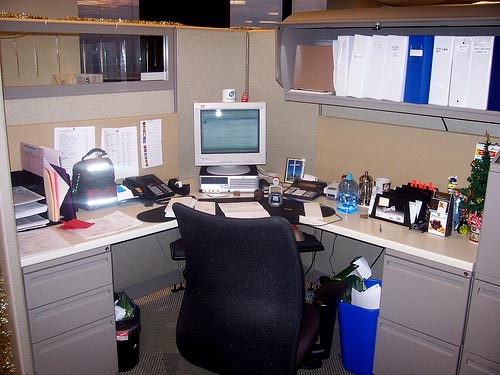Collaboration is a crucial aspect of work in most hi-tech companies. Office cubicles, for better or worse, are also present in many of them. You’d think, therefore, that the latter would be designed to facilitate the former…
No such luck, however. Consider the most common type of desk seen in the cube farms.

Image courtesy GraceFamily, shared on flickr under CC license.
The basic concept seems to make sense: the L-shaped desk, bridged at the angle by a diagonal area for the keyboard, allows one to sit facing the screen while having everything else – phone, file trays, drawers, and the perennial coffee mug – within easy reach. It’s the knowledge worker’s dream setup, it seems. The misanthropic knowledge worker, that is…
Think about it: the L desk pretty much guarantees that two people will never be able to comfortably collaborate in this cube. If one of them is at the keyboard, the second must squeeze in behind this user’s back. This explains why people so often go to a cafeteria or conference room to talk: their own office is meant for solo work only.
Kudos to my friend Michael, then. An engineer at a hi-tech plant, Michael kicked out the standard corner desk and managed to commandeer a rectangular straight table instead. Less fancy, but now he could host a coworker in a side-by-side sitting configuration, all in the same size of cubicle!


This particular type of office configuration also happens to drive people crazy due to the ongoing distraction of having other workers walking behind you, reading over your shoulder, etc. It’s a rare person who can entirely shut off the favored-by-evolution apparatus that keeps track of sounds occuring behind one’s back.
Open office design often more closely resembles Jeremy Bentham’s Panopticon (and perhaps with the same underlying design intent!) than it does anything truly optimized for productive knowledge work.
Knowledge workers need space/configurations that give them the ability to move back and forth between an ambience of privacy and one that fosters teamwork.